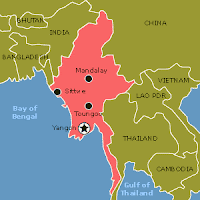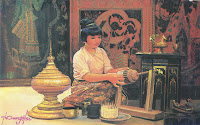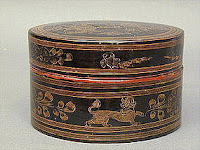I was fortunate to become acquainted with Burmese handicrafts while living and working in Singapore and Pakistan. During my travels to Thailand I had the opportunity to visit many artists and handicrafts centers showcasing the richness of Burmese art. I was particularly intrigued by Burmese lacquerware, which is used widely in day-to-day life and also in Buddhist rituals. Most of the containers I collected over the years are betel boxes.
Lacquer comes from the sap of the wild Melanorrhoea usitata tree and is naturally black. The addition of different elements produces different colors, for example cinnabar produces red and indigo blue. Once the basic form of the vessel has been made of either wood or bamboo, it is sealed by a coat of lacquer mixed with fine clay, which then needs to dry for 3 – 10 days. The surface is then again smoothed and polished and another sealing layer is applied. This process is repeated many times. The final coat is of fine, glossy-quality lacquer.
In addition to “plain” containers there are also those depicting scenes (many of the scenes depicted are courts scenes). To carve a scene into a container designs are incised into the lacquer, which are then filled with another color, sealed, dried and polished. This process of repeated for each separate color which creates a long and complicated process.
19th and 20th century lacquer betel boxes
Betel leaves are placed at the bottom of the box. Above are two shallow trays: the lower one often contains dried tobacco and the upper, tiny containers hold lime, sliced areca nuts, cloves and other ingredients.
The boxes have come in very handy – sometimes I use them to store small items, other times they are used for floral arrangements (a glass jar filled with water is placed inside the lacquer box to protect it).
(Author's note: Due to our recent move from Europe to the U.S. I was not able to access photos of my lacquerware collection for this post. Photos shown here are images I found on google. Sources were handwritten materials and the book "Burma and the Art of Lacquer)
Sanni
Sanni





Liebe Sanni,
AntwortenLöschenvielen Dank für diesen wundervollen Post! Du hast mich mit Deiner Liebe zu den Gewürzdosen angesteckt :-)
Liebe Grüße,
Markus
Das ist wirklich ein interessanter Bericht! So schöne Gefäße mit denen man bestimmt schöne Sachen machen kann.
AntwortenLöschenLiebe Grüße,
Claudia
Guten MOrgen,
AntwortenLöschenerstaunlich wie klein die Welt wird durch das Internet, in diese Dosen könnte ich mich auch verlieben. Leider kann ich diesen KOmmentar nicht auf englisch schreiben, es reicht gerade um den Bericht zu verstehen.
Vielen Dank für den interessanten Einblich in eine mir fremde Welt.
Liebe Grüße
Sanne
Toll! Danke für den Bericht, er ist sehr interessant!
AntwortenLöschenViele Grüße,
Dagmar
Das sind ja sehr schöne Dosen und jede könnte sicher eine lange Geschichte erzählen!
AntwortenLöschenDanke für diesen interessanten Post!
Liebe Grüsse
Cornelia
Das sind wirklich schöne Dosen. Und so vielfältig. Ich kann mir gut vorstellen, wie sie mit einem Blumenstrauß aussehen.
AntwortenLöschenViele Grüße,
Edith